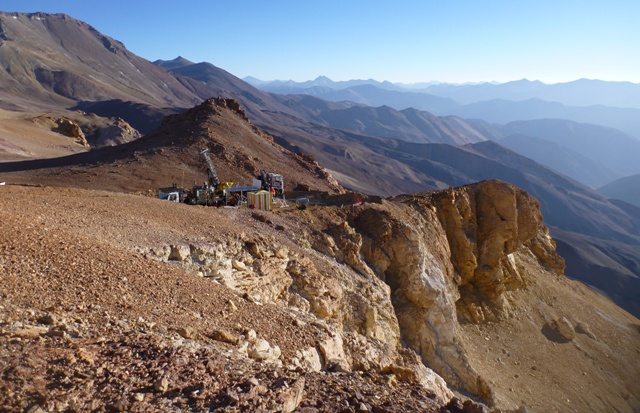VANCOUVER — Barrick Gold (TSX: ABX; NYSE: ABX) has uncovered a hidden gold deposit known as Alturas, in Chile’s gold-rich El Indio district, 30 km south of the former El Indio mine.
Barrick announced the discovery as part of its first-quarter results, and described Alturas as being geologically similar to the company’s giant Veladero gold mine across the border in Argentina, with the added potential of being significantly higher grade.
Veladero is a high sulphidation, epithermal gold deposit with proven and probable reserves of 4.7 million oz. gold within 172 million tonnes of 0.86 gram gold per tonne. The Veladero mine produced 722,000 oz. gold in 2014 at all-in sustaining costs of US$815 per oz.
“I’m absolutely thrilled at our team’s latest achievement at Alturas, and I’m especially proud at how we actually made the discovery,” Rob Krcmarov, Barrick’s senior vice-president of global exploration, tells The Northern Miner during a phone interview.
Barrick has identified oxidized gold mineralization averaging 1-2 grams gold per tonne over 50- to 150-metre drill intervals. Results have included higher grade hits such as 97 metres of 4.4 grams gold and 170 metres of 2.76 grams gold.
The deposit has been traced over 1 sq. km, and although it daylights towards the west, Krcmarov says it’s still open in other directions at depths of 100 to 200 metres.
Haywood Securities analyst Kerry Smith estimates the deposit could have 3 to 7 million oz. gold with grades averaging 1 to 1.5 grams gold. Krcmarov says more work is needed before Barrick can release a maiden resource for Alturas, a goal the company is working towards along with a scoping study.
According to Krcmarov, the company first drilled Alturas back in 2012 — a couple years after the company had initiated a large-scale re-evaluation of its tenements across the highly prospective, 140 km long El Indio Belt.
The reevaluation was primarily due to the increasing complexity of discovering economic deposits concealed beneath the barren Andean landscape.
“Traditional prospecting techniques such as sediment geochemistry can barely detect the mineralization associated with epithermal systems,” he explains. “We have a big advantage at Barrick because not only are we incredibly familiar with these systems, but we have access to targeting criteria that’s not in any published literature.”
Krcmarov adds that the company performed sampling and mapping across the belt, and followed up on high priority targets with remote sensing techniques which later led them to Alturas. But he comments that the biggest pay-off came from patience.
“We told ourselves to be patient, and rather than drilling targets in chronological order after identifying them, we waited until we evaluated the whole belt and chose the best targets to shoot for,” he says. “It worked spectacularly well. Alturas came out as our top target and it turned out to be highly successful.”
The deposit had been hidden beneath a large blanket of barren alteration called a “lithocap”, but geologists found sniffs of mineralization where the deposit “daylights” or outcrops along some ridges towards the west.
He says the first hole into the deposit took a small “bite” of the deposit, returning 11 metres of 1 gram gold. But follow-up drilling proved “remarkably efficient” at outlining the deposit, with 77% of holes hitting ore grades. And as infill drilling continues, he says, the team’s excitement and confidence continues to build.
“Everyone has been integral at enabling our success and moving this project forward,” he says. “It’s not only our highly skilled technical specialists, but also our community relations, drilling services and environment groups as well. It has really been a team effort.”


Be the first to comment on "Barrick’s Alturas discovery could be the next Veladero"